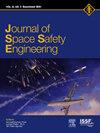Estimation of ejecta generation and mitigation measures for large-scale structures on geostationary orbit
IF 1.7
Q3 ENGINEERING, AEROSPACE
引用次数: 0
Abstract
Large-scale structures have a non-negligible collision probability with micrometeoroid and orbital debris (MMOD) due to their massive size, even in geostationary orbit (GEO) with low debris flux. When MMOD impact the spacecraft surfaces at high velocity, secondary debris called ejecta are generated, and they may remain semi-permanently and accumulate because there is no atmospheric drag at high altitudes such as GEO. To evaluate the amount of ejecta generation, hypervelocity impact tests were conducted for the material for future large-scale structures or material commonly used in conventional spacecraft, such as CFRP honeycomb panels and solar cells. The effect of impact energy on ejecta generation was evaluated by changing the impact velocity and projectile density. Impact tests were also conducted on irradiated samples to investigate the effects of environmental degradation due to long-term exposure to orbit. The results showed that the amount of ejecta increased with impact energy and may have been affected by radiation-induced degradation. Next, hypervelocity impact tests were conducted to investigate the measures to reduce ejecta, and it was shown that the ejecta generation could be reduced by using low-density materials such as polyimide foam and silica aerogel.
地球静止轨道大型结构抛射物生成量估算和减缓措施
大型结构由于体积庞大,与微流星体和轨道碎片(MMOD)发生碰撞的概率不可忽略,即使在碎片通量较低的地球静止轨道(GEO)上也是如此。当微流星体和轨道碎片以高速撞击航天器表面时,会产生被称为抛射物的二次碎片,由于在地球同步轨道等高空没有大气阻力,这些碎片可能会半永久性地滞留和累积。为了评估弹射物的产生量,对未来大型结构的材料或常规航天器中常用的材料(如 CFRP 蜂窝板和太阳能电池)进行了超高速撞击试验。通过改变冲击速度和射弹密度,评估了冲击能量对喷出物产生的影响。还对经过辐照的样品进行了撞击试验,以研究长期暴露在轨道上造成的环境退化的影响。结果表明,抛射物的数量随撞击能量的增加而增加,可能受到辐射引起的降解的影响。接着进行了超高速撞击试验,以研究减少弹射物的措施,结果表明,使用聚酰亚胺泡沫塑料和二氧化硅气凝胶等低密度材料可以减少弹射物的产生。
本文章由计算机程序翻译,如有差异,请以英文原文为准。
求助全文
约1分钟内获得全文
求助全文
来源期刊

Journal of Space Safety Engineering
Engineering-Safety, Risk, Reliability and Quality
CiteScore
2.50
自引率
0.00%
发文量
80
 求助内容:
求助内容: 应助结果提醒方式:
应助结果提醒方式:


